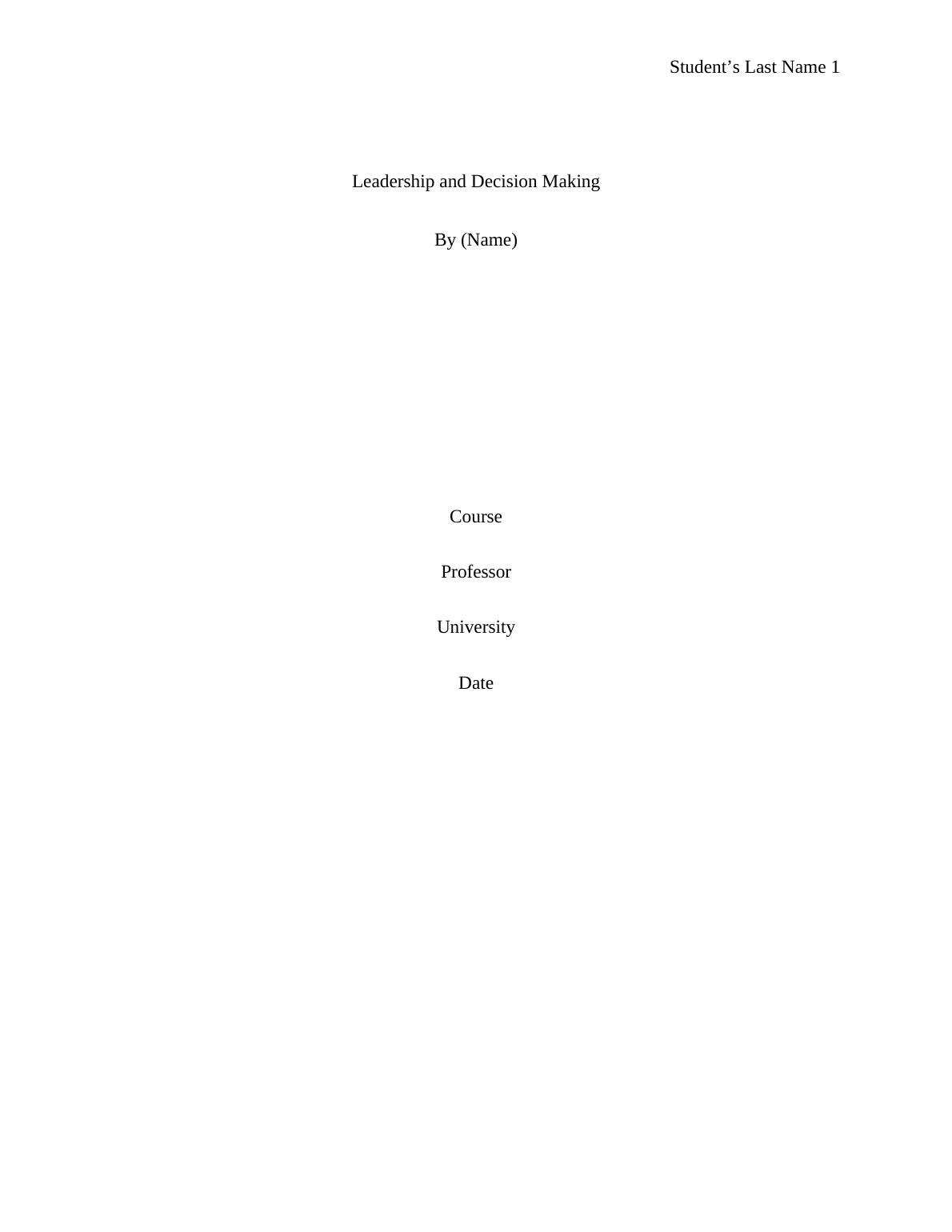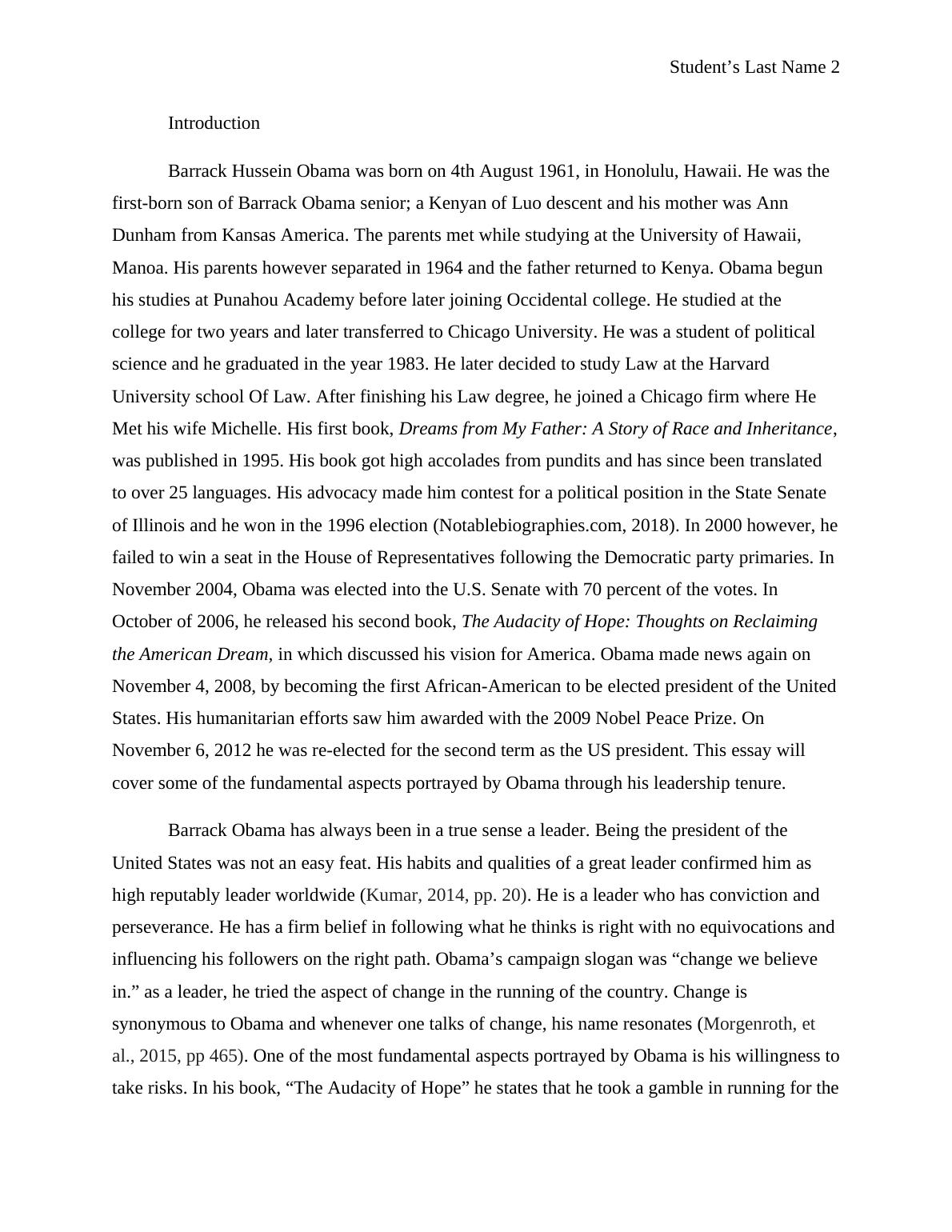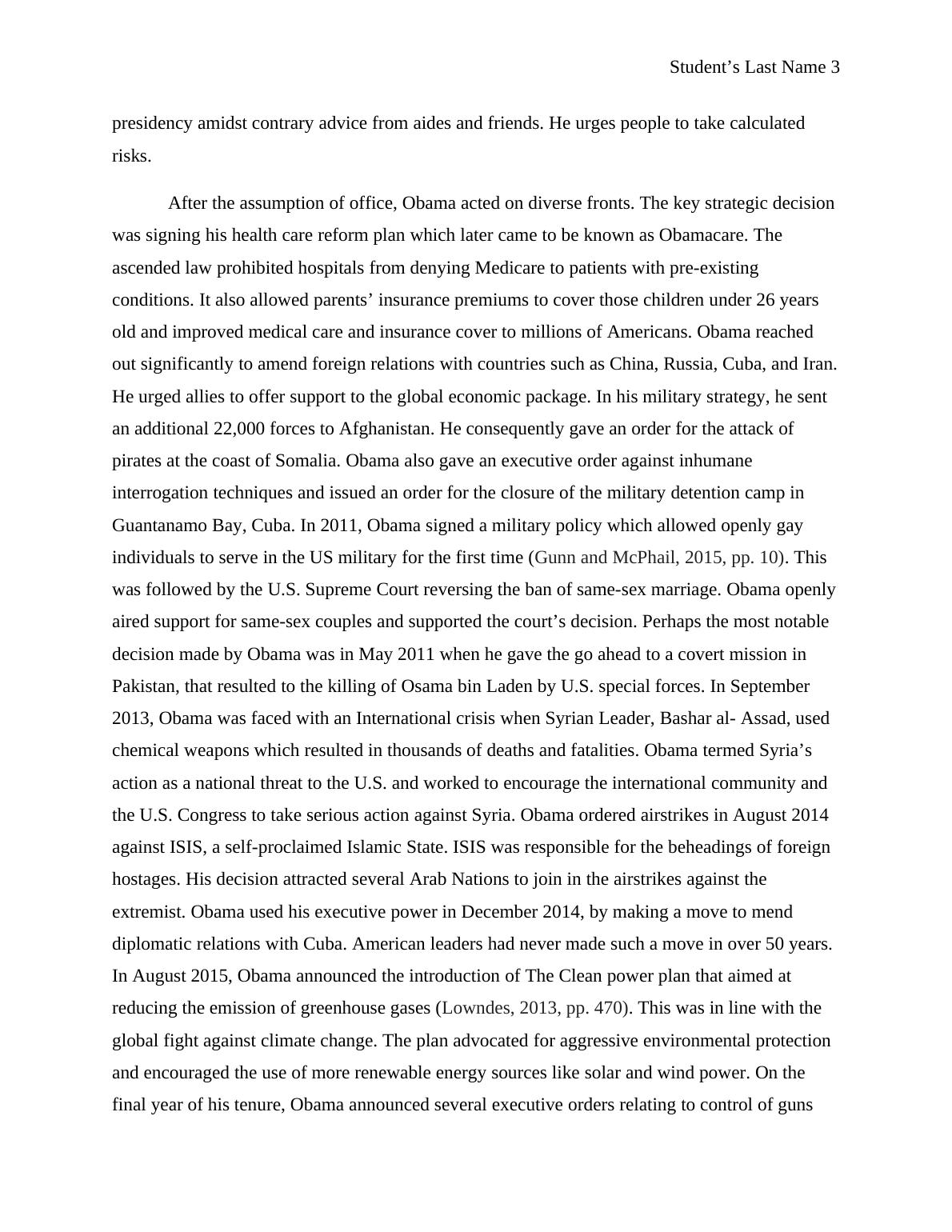Leadership and Decision Making PDF
Added on 2021-10-12
9 Pages2963 Words62 Views
Student’s Last Name 1
Leadership and Decision Making
By (Name)
Course
Professor
University
Date
Leadership and Decision Making
By (Name)
Course
Professor
University
Date

Student’s Last Name 2
Introduction
Barrack Hussein Obama was born on 4th August 1961, in Honolulu, Hawaii. He was the
first-born son of Barrack Obama senior; a Kenyan of Luo descent and his mother was Ann
Dunham from Kansas America. The parents met while studying at the University of Hawaii,
Manoa. His parents however separated in 1964 and the father returned to Kenya. Obama begun
his studies at Punahou Academy before later joining Occidental college. He studied at the
college for two years and later transferred to Chicago University. He was a student of political
science and he graduated in the year 1983. He later decided to study Law at the Harvard
University school Of Law. After finishing his Law degree, he joined a Chicago firm where He
Met his wife Michelle. His first book, Dreams from My Father: A Story of Race and Inheritance,
was published in 1995. His book got high accolades from pundits and has since been translated
to over 25 languages. His advocacy made him contest for a political position in the State Senate
of Illinois and he won in the 1996 election (Notablebiographies.com, 2018). In 2000 however, he
failed to win a seat in the House of Representatives following the Democratic party primaries. In
November 2004, Obama was elected into the U.S. Senate with 70 percent of the votes. In
October of 2006, he released his second book, The Audacity of Hope: Thoughts on Reclaiming
the American Dream, in which discussed his vision for America. Obama made news again on
November 4, 2008, by becoming the first African-American to be elected president of the United
States. His humanitarian efforts saw him awarded with the 2009 Nobel Peace Prize. On
November 6, 2012 he was re-elected for the second term as the US president. This essay will
cover some of the fundamental aspects portrayed by Obama through his leadership tenure.
Barrack Obama has always been in a true sense a leader. Being the president of the
United States was not an easy feat. His habits and qualities of a great leader confirmed him as
high reputably leader worldwide (Kumar, 2014, pp. 20). He is a leader who has conviction and
perseverance. He has a firm belief in following what he thinks is right with no equivocations and
influencing his followers on the right path. Obama’s campaign slogan was “change we believe
in.” as a leader, he tried the aspect of change in the running of the country. Change is
synonymous to Obama and whenever one talks of change, his name resonates (Morgenroth, et
al., 2015, pp 465). One of the most fundamental aspects portrayed by Obama is his willingness to
take risks. In his book, “The Audacity of Hope” he states that he took a gamble in running for the
Introduction
Barrack Hussein Obama was born on 4th August 1961, in Honolulu, Hawaii. He was the
first-born son of Barrack Obama senior; a Kenyan of Luo descent and his mother was Ann
Dunham from Kansas America. The parents met while studying at the University of Hawaii,
Manoa. His parents however separated in 1964 and the father returned to Kenya. Obama begun
his studies at Punahou Academy before later joining Occidental college. He studied at the
college for two years and later transferred to Chicago University. He was a student of political
science and he graduated in the year 1983. He later decided to study Law at the Harvard
University school Of Law. After finishing his Law degree, he joined a Chicago firm where He
Met his wife Michelle. His first book, Dreams from My Father: A Story of Race and Inheritance,
was published in 1995. His book got high accolades from pundits and has since been translated
to over 25 languages. His advocacy made him contest for a political position in the State Senate
of Illinois and he won in the 1996 election (Notablebiographies.com, 2018). In 2000 however, he
failed to win a seat in the House of Representatives following the Democratic party primaries. In
November 2004, Obama was elected into the U.S. Senate with 70 percent of the votes. In
October of 2006, he released his second book, The Audacity of Hope: Thoughts on Reclaiming
the American Dream, in which discussed his vision for America. Obama made news again on
November 4, 2008, by becoming the first African-American to be elected president of the United
States. His humanitarian efforts saw him awarded with the 2009 Nobel Peace Prize. On
November 6, 2012 he was re-elected for the second term as the US president. This essay will
cover some of the fundamental aspects portrayed by Obama through his leadership tenure.
Barrack Obama has always been in a true sense a leader. Being the president of the
United States was not an easy feat. His habits and qualities of a great leader confirmed him as
high reputably leader worldwide (Kumar, 2014, pp. 20). He is a leader who has conviction and
perseverance. He has a firm belief in following what he thinks is right with no equivocations and
influencing his followers on the right path. Obama’s campaign slogan was “change we believe
in.” as a leader, he tried the aspect of change in the running of the country. Change is
synonymous to Obama and whenever one talks of change, his name resonates (Morgenroth, et
al., 2015, pp 465). One of the most fundamental aspects portrayed by Obama is his willingness to
take risks. In his book, “The Audacity of Hope” he states that he took a gamble in running for the

Student’s Last Name 3
presidency amidst contrary advice from aides and friends. He urges people to take calculated
risks.
After the assumption of office, Obama acted on diverse fronts. The key strategic decision
was signing his health care reform plan which later came to be known as Obamacare. The
ascended law prohibited hospitals from denying Medicare to patients with pre-existing
conditions. It also allowed parents’ insurance premiums to cover those children under 26 years
old and improved medical care and insurance cover to millions of Americans. Obama reached
out significantly to amend foreign relations with countries such as China, Russia, Cuba, and Iran.
He urged allies to offer support to the global economic package. In his military strategy, he sent
an additional 22,000 forces to Afghanistan. He consequently gave an order for the attack of
pirates at the coast of Somalia. Obama also gave an executive order against inhumane
interrogation techniques and issued an order for the closure of the military detention camp in
Guantanamo Bay, Cuba. In 2011, Obama signed a military policy which allowed openly gay
individuals to serve in the US military for the first time (Gunn and McPhail, 2015, pp. 10). This
was followed by the U.S. Supreme Court reversing the ban of same-sex marriage. Obama openly
aired support for same-sex couples and supported the court’s decision. Perhaps the most notable
decision made by Obama was in May 2011 when he gave the go ahead to a covert mission in
Pakistan, that resulted to the killing of Osama bin Laden by U.S. special forces. In September
2013, Obama was faced with an International crisis when Syrian Leader, Bashar al- Assad, used
chemical weapons which resulted in thousands of deaths and fatalities. Obama termed Syria’s
action as a national threat to the U.S. and worked to encourage the international community and
the U.S. Congress to take serious action against Syria. Obama ordered airstrikes in August 2014
against ISIS, a self-proclaimed Islamic State. ISIS was responsible for the beheadings of foreign
hostages. His decision attracted several Arab Nations to join in the airstrikes against the
extremist. Obama used his executive power in December 2014, by making a move to mend
diplomatic relations with Cuba. American leaders had never made such a move in over 50 years.
In August 2015, Obama announced the introduction of The Clean power plan that aimed at
reducing the emission of greenhouse gases (Lowndes, 2013, pp. 470). This was in line with the
global fight against climate change. The plan advocated for aggressive environmental protection
and encouraged the use of more renewable energy sources like solar and wind power. On the
final year of his tenure, Obama announced several executive orders relating to control of guns
presidency amidst contrary advice from aides and friends. He urges people to take calculated
risks.
After the assumption of office, Obama acted on diverse fronts. The key strategic decision
was signing his health care reform plan which later came to be known as Obamacare. The
ascended law prohibited hospitals from denying Medicare to patients with pre-existing
conditions. It also allowed parents’ insurance premiums to cover those children under 26 years
old and improved medical care and insurance cover to millions of Americans. Obama reached
out significantly to amend foreign relations with countries such as China, Russia, Cuba, and Iran.
He urged allies to offer support to the global economic package. In his military strategy, he sent
an additional 22,000 forces to Afghanistan. He consequently gave an order for the attack of
pirates at the coast of Somalia. Obama also gave an executive order against inhumane
interrogation techniques and issued an order for the closure of the military detention camp in
Guantanamo Bay, Cuba. In 2011, Obama signed a military policy which allowed openly gay
individuals to serve in the US military for the first time (Gunn and McPhail, 2015, pp. 10). This
was followed by the U.S. Supreme Court reversing the ban of same-sex marriage. Obama openly
aired support for same-sex couples and supported the court’s decision. Perhaps the most notable
decision made by Obama was in May 2011 when he gave the go ahead to a covert mission in
Pakistan, that resulted to the killing of Osama bin Laden by U.S. special forces. In September
2013, Obama was faced with an International crisis when Syrian Leader, Bashar al- Assad, used
chemical weapons which resulted in thousands of deaths and fatalities. Obama termed Syria’s
action as a national threat to the U.S. and worked to encourage the international community and
the U.S. Congress to take serious action against Syria. Obama ordered airstrikes in August 2014
against ISIS, a self-proclaimed Islamic State. ISIS was responsible for the beheadings of foreign
hostages. His decision attracted several Arab Nations to join in the airstrikes against the
extremist. Obama used his executive power in December 2014, by making a move to mend
diplomatic relations with Cuba. American leaders had never made such a move in over 50 years.
In August 2015, Obama announced the introduction of The Clean power plan that aimed at
reducing the emission of greenhouse gases (Lowndes, 2013, pp. 470). This was in line with the
global fight against climate change. The plan advocated for aggressive environmental protection
and encouraged the use of more renewable energy sources like solar and wind power. On the
final year of his tenure, Obama announced several executive orders relating to control of guns

End of preview
Want to access all the pages? Upload your documents or become a member.
Related Documents
Obama's Leadership Skills Profile Analysis 2022lg...
|9
|2668
|22
Interview with Barack Obama: Life, Politics, and Legacylg...
|11
|3271
|423
Project Leader Barack Obama: A Transformational Leader and His Impact on Obamacarelg...
|10
|2100
|188
Analyzing Barack Obama's 2008 Speechlg...
|6
|815
|86
Making Sense of Society: The Sociological Imagination - Family and Race/Ethnicity Analysis of Barack Obamalg...
|7
|1994
|438
Joe Biden: Life, Campaigns, and Supportlg...
|8
|2236
|20
